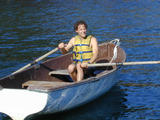First impressions from the first Beam Reach
It has been marvellous and frustrating to be administering Beam Reach from Seattle on the first days of the fall 2006 program. I feel a simultaneous urge to rush up and be part of every moment in the syllabus and a great satisfaction that the Beam Reach ship is sailing along without me being involved in adjusting every line.
I hope this first blogbook entry will inspire new students and instructors alike to share their experiences on-line. It really is a rare thing these days to delve deeply into a critical issue and one’s own curiosities. That our research theme centers on orcas, an inherently awe-inspiring and communicative species, just makes the opportunity that much more intriguing.
I’d like to share two journal entries I made almost precisely a year ago, during the first couple days of the first Beam Reach program. They drive home the sense I have again today: that we are just scratching the surface of our human involvement in the decline and unprecedented alteration of the oceans.
Sunday 08/21/2005 05:30
“How much does an ecosystem have to change before we alter our values to restore it? To answer the question, one really has to do two difficult things: understand the ecosystem well enough to determine which human actions are driving the change; and discern what changes in human behavior will benefit the ecosystem at least cost.
Beam Reach is all about addressing this question in the marine environment through sustainability science. This is daunting because it is technologically difficult to analyze how marine ecosystems function and to quantify the costs/benefits of human actions within them. It is also a challenge because scientists are used to understanding a ecosystem problem, but have not traditionally studied how to solve it (through economic, technological, and/or political methods).
In the Pacific Northwest, we have an interesting range of cases in which this broad question has been tackled. Invariably they begin with the decline of a species — whether high-profile or obscure — and evolves to a broad investigation of its ecosystem. At present, we are considering a charismatic megafaunum, the southern resident orcas. We are also currently struggling with another deeply valued animal, the wild salmon. We can report the successful restoration of the iconic American bald eagle. Great sums have been invested recently in assessing the Stellar sea lion, which most people don’t value in particular. And we are still evaluating the status of the northern spotted owl, a species that many people hate as much as orcas used to be reviled.
If it turns out that noise from cargo ships is the main risk to orcas staying in residence, at what point will human individuals and society mitigate the acoustic impact? Will orcas, inherently wonderful and with ecotourism value of about $1M/animal, be compared economically with the goods being transported through the great ports of our region? How much would it cost to make those ships quiet?”
Wednesday 08/24/2005 (2:05am 8/25)
“It is strange to reside in such a beautiful marine setting while reading articles and hearing speakers declare emphatically that marine ecosystems are in collapse. With a nostalgia as invigorating as the fresh evening air, I stepped out onto the Fernald Lab deck to gaze at the half-full, waning moon. Friday Harbor rippled in the dark waters and the wet beach glistened beneath me. After strolling back to the duplex, I found emailed news about marine extinctions and prepared to introduce 2 speakers who document the decline of pelagic fish and orcas in our oceans.
Bleary eyed, I ease into bed wondering where the southern residents are tonight. Are we really helping the whales, as I tell my son Liam when he asks what I do with Beam Reach?”
Just as I came across unnerving news regarding the marine plight last year, today I came across an L.A. Times series called “Altered Oceans.” Reading through the part on ocean acidification while my newborn daughter snored beside me, I was felt downright worried about the anthropogenic perturbations of the globe we are set to experience in the 21st century. Nevertheless, I am optimistic that Beam Reach is a small step in the right direction and I’m very excited to continue contemplating how to forge a sustainable relationship between humanity and the seas.
—–
Read More



 Twitter
Twitter LinkedIn
LinkedIn Facebook
Facebook